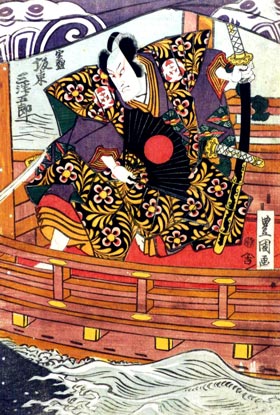| YABASE NO URA - KOJď |
| Play title | Genpei Nunobiki no Taki The Genji, the Heike and the Nunobiki Waterfalls |
| Authors | Namiki Senryű I Miyoshi Sh˘raku |
| History |
The play in five acts "Genpei Nunobiki no Taki" was originally written for the puppets theater in 1749 It was adapted for Kabuki in the 9th lunar month of 1757, produced by the zamoto Anegawa Daikichi I in ďsaka at the Kado no Shibai (casting unknown). It was staged in Edo for the first time in the 1st lunar month of 1757 at the Moritaza. |
| Structure |
The short "Yabase no Ura" and "Koj˘" are the first two scenes of the third act of the play "Genpei Nunobiki no Taki", which is ended by the long and popular "Sanemori Monogatari". |
| Key words |
Biwako Chikubushima Genji Genpei Kassen Genpei-kassenmono Gidayű Ky˘gen Gozabune Heike Jidaimono Sait˘ Sanemori Shirohata Taira Munemori Yabase no Ura |
| Summary |
Summary of the end of the previous act ("Yoshikata Saigo") Yoshikata, the Genji general, is living in his Ky˘to mansion with Aoi Gozen, his wife who is now pregnant. Kurosuke, a farmer, visits the mansion with Koman, his daughter, and Tarokichi, her son. Soon a Heike unit appears to attack Yoshikata. After Kurosuke has fled with Aoi Gozen and Tarokichi to safety, Yoshikata hands the white banner of the Genji to Koman and asks her to follow them. Yabase no Ura Carrying the white banner concealed in her kimono, Koman arrives at the beach of Yabase Bay when Chűta and other Heike warriors overtake her and try to wrest the banner from her. Koman valiantly fights them off with a show of unwomanly strength but at last it seems impossible for her to resist the attack any longer. So she jumps into Lake Biwa in order to prevent the banner from falling into enemy hands. Koj˘ Returning from a visit to the shrine on Chikubu Island on Lake Biwa, Munemori, son of the head of the Heike clan, is on board a boat (gozabune) heading for the Shiga beach. Beside him is Saemon, one of his retainers. Another vessel carrying Sanemori, a Heike general, approaches and Sanemori calls his greetings to Munemori. Munemori and Saemon invite Sanemori on board their own boat and the three exchange cups of sake. While they are drinking, Sanemori notices a young woman swimming toward them but on the point of exhaustion and likely to drown. With the aid of the sailors Sanemori catches her and draws her on board. When she can recover her voice the girl thanks her rescuers and says that her name is Koman. This means nothing to Sanemori, but when he reveals his own identity as one of the Heike clansmen, Koman, an ardent supporter of the Genji clan, is desperate at finding herself in the hands of her enemies. In fact, she was escaping from some other Heike clansmen when rescued by Sanemori and now her pursuers come up to the boat in their own small craft. They call to Munemori that she escaped from them when they tried to wrest from her the white banner of the Genji, which, tightly furled, she still has in her hand. Saemon turns quickly and tries to take the banner but Koman holds it high above her head, determined that it shall never fall into enemy hands. Sanemori slashes at her with his sword and her severed arm, still clutching the banner, falls into the waters of the lake, followed by the lifeless body of the noble girl. Text written by Hironaga Shűzabur˘ |
 |
 |
|
The actors Nakamura Matsue III (left) and Band˘ Mitsugor˘ III (right)
playing the roles of Koman and Sait˘ Bett˘ Sanemori
in the "Koj˘" scene of the drama "Genpei Nunobiki no Taki",
which was staged in the 9th lunar month of 1816 at the Nakamuraza |
|
|
|
| Contact | Main | Top | Updates | Actors | Plays | Playwrights | Programs | Links | FAQ | Glossary | Chronology | Illustrations | Prints | Characters | Derivatives | Theaters | Coming soon | News |